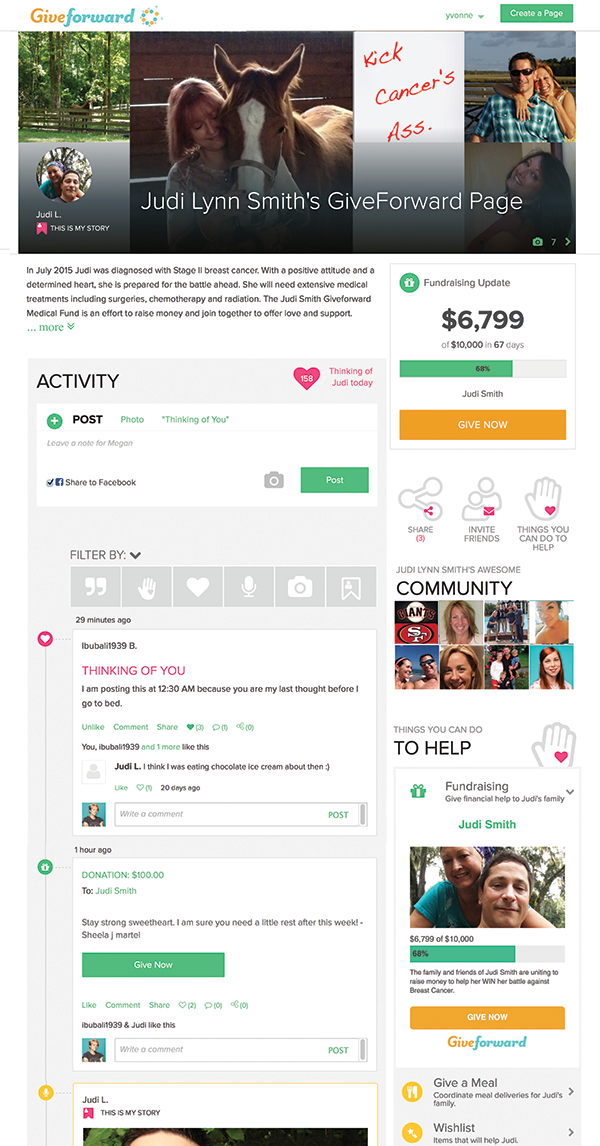Earlier this year, when my cousin’s daughter was diagnosed with Budd-Chiari Syndrome, a rare liver disorder, a family friend started a fundraising campaign on the crowdfunding website gofundme.com to offset the cost of her extended hospital stay.
“When I heard the news, I was extremely saddened that this was happening to a child let alone someone I knew, and I decided I needed to do something to help,” says Pam Huber-Taylor of Williamsport, Pennsylvania, who set up the online campaign last January. Thanks to donations mainly from relatives and friends, $9,875 out of a goal of $10,000 has been raised.
“Donations went anywhere between $5 up to $2,000,” Huber-Taylor says. “I was amazed at how easy it was to set up this account as they have everything posted on their website.”
Crowdfunding—seeking funds online from the public—has been gaining in popularity. Funeral expenses, business ventures, dream vacations, home repairs and veterinarian bills are among the campaigns that people crowdfund. Most notably, though, are medical expenses. There are more than 800 fundraising campaigns on GoFundMe created by people in Hampton Roads and Richmond, Virginia, seeking monetary assistance for dealing with a range of health issues, from cancer and other diseases to vehicle and burn accidents to other surgeries and medical expenses.
Lauren Maxwell started an account on GoFundMe in June for her father, Cronan John Maxwell of Williamsburg, Virginia, after she learned he had developed cancer. “When I found out about my father’s diagnosis, I felt helpless because I live far away, and I felt that a fundraising campaign would help the most,” Maxwell shares.
So far, her campaign has generated more than $4,000. The greatest contributors have been family and friends, though some people Maxwell doesn’t know have also felt compelled to donate to her cause.
“I have had a few donations from complete strangers,” Maxwell says. “Early on in the campaign, one man from England donated $100, and wrote a long, very uplifting message.”
Ethan Austin, co-founder of the website giveforward.com, helped start the site to combat colon cancer in memory of his father.
“People raise funds on GiveForward primarily for medical expenses, memorial funds, recovery from fires and natural disasters such as floods and earthquakes, life events such as adoption, and pet medical expenses,” Austin says. “We have 14,000 such fundraisers at the moment. The average amount raised per campaign for medical expenses is more than $3,000, but we’ve seen several such fundraisers reach into the hundreds of thousands of dollars. We’ve seen them as high as nearly $900,000.”
Ray Milano of Spotsylvania County, Virginia, started a drive on GiveForward to support his best friend Mike Witt, who broke his neck after falling out of a bucket truck last year.
“We raised $2,000 in the first 24 hours,” Milano says. “Donations have come from various people, clients, family, friends, even people who didn’t know Mike, but heard his story. We’ve raised $19,000 so far. It’s been incredible.”
Most crowdfunding websites are easy to navigate, with instructions on how to start a fundraiser available online, while other sites provide assistance over the telephone. Those who start a campaign share their plight and set an attainable monetary goal.
Katie Smith of Williamsburg started a campaign on helphopelive.org last year after her brother suffered a traumatic injury during a swimming accident.
“I knew that he would have a very long journey with a lot of medical bills given the nature and severity of his injury,” Smith says. “The site has been very successful. I did not set any fundraising goals, as we were just grateful for any and all donations. We ended up raising $12,576 to date.” The money came from family, friends and acquaintances, as well as a few donors who chose to remain anonymous.
It’s not just humans who need help with medical expenses. XOXO Pet Rescue, Inc., an animal rescue group serving Hampton Roads uses two crowdfunding sites to fund animal surgeries and other needs.
“We have had varying success,” says Keri Penland, president of the animal rescue organization. “Some dogs have reached a goal in a few days, while others have not gotten much funds even after weeks. We are not sure why some appeal to people while others don’t pull the heartstrings. I believe it may depend on the story, and the photos.”
Still, “We have been surprised,” says Penland. “We are much more willing to take on very hard, and expensive cases now that we know this resource is out there. We recently took in Peanut, who needed an MRI and other expensive long-term help. We didn’t hesitate because we knew we could reach out to the public for help.”
XOXO Pet Rescue, Inc. has received donations from those locally and remote.
“We have gotten money from everywhere,” she says. “Anywhere from $5 to $1,000 from one donor.”
When seeking funds, particularly from strangers, Penland suggests being reasonable.
“Make the goal attainable, but don’t be afraid to ask for what is really needed,” she shares. “Let people know every dollar gets you one dollar closer to your goal. Also, pictures matter. When you are hitting a slump in funds, be sure to update. People like to hear about how the recipient is doing, good or bad. They want to see updates and news. They have an investment in the health of the recipient now and feel connected, so keep them posted.”
There are drawbacks to crowdfunding. While these sites don’t typically charge a fee to create an account, they do take a percentage of each donation, some as high as 8 percent. But, that small expense outweighs the cost of trying to save someone’s life, points out Huber-Taylor, who adds that donating online is easier and more convenient for some people, as well. “Although there is a fee, it is well worth it,” she says.
Crowdfunding could be the way of the future, especially when it comes to dealing with health issues.
“I think that anybody that goes through struggles in life should not be embarrassed to ask for help,” says Huber-Taylor.
Case Study: Going Beyond Money
In addition to offering a means for financial support, GiveForward.com recently launched online social communities where people can provide emotional support and other services to those suffering from various medical conditions. The website expanded in October to coincide with Breast Cancer Awareness Month.
Judi Lynn Smith, who was diagnosed with stage 2 breast cancer in July, appreciates the website’s new features.
“Sometimes all it takes is a kind word from someone who cares to turn your whole world around,” Smith shares. “GiveForward has been a place for all those people who care to gather, to stay in touch and to keep up with how my journey is going. This has been more than a fundraiser. It’s been an incredibly emotional experience.”
At GiveForward, people not only have the opportunity to make a monetary contribution, but can also send an encouraging message, provide a meal, or donate other helpful items to patients in need.
“In addition to more ways to give, an enhanced activity feed allows GiveForward communities to easily network and communicate in real-time, post updates, anecdotes, memories, photos, like and share them, even filter them,” says Jay Foot, director of communications for GiveForward. “These additional giving options and communication enhancements make GiveForward the central hub for people who want to take action, organize and rally practical, emotional and financial support.”


